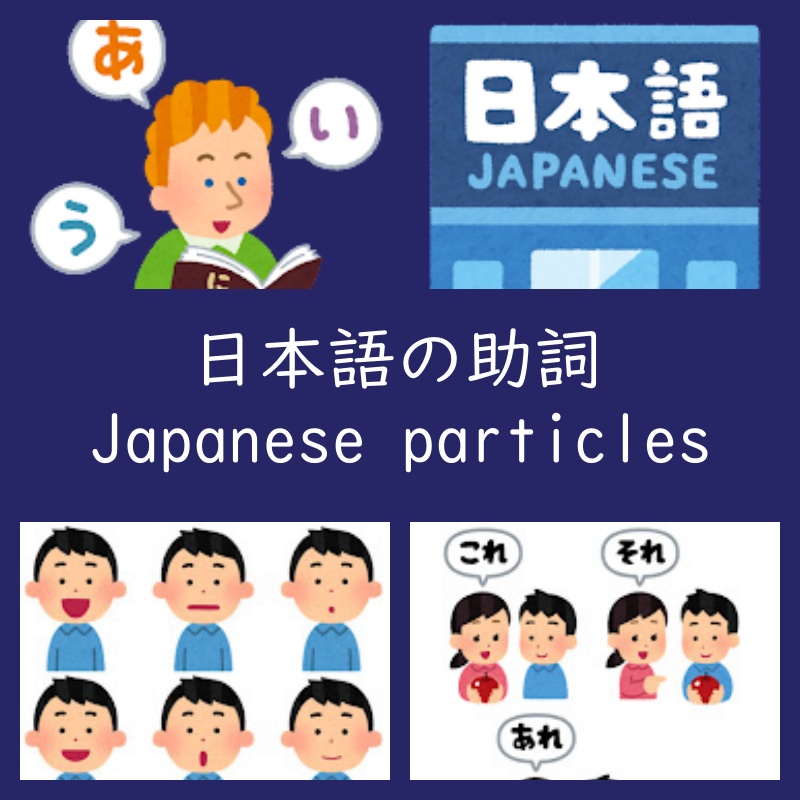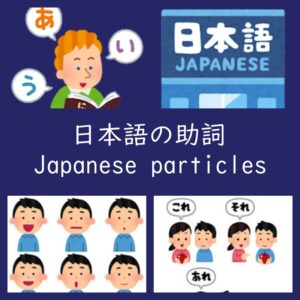それでは、日本語の12個の基本的な助詞の使い方を見ていきましょう。
Let’s take a look at 12 basic Japanese particles.

目次(Contents)
日本語の助詞(Japanese Particles)
🐱マークは、ぜひ習得したい基本の使い方です。
は
🐱Topic
- わたしは フィリピンじん です。I am Filipino.
- かれは せが たかい。He’s tall.
Comparison
- にくは好きですが、さかなは好きじゃないです。I like meat, but not fish.
- 日本のなつは あついですが、ふゆは さむいです。Summer in Japan is hot, but winter is cold.
Lowest expectation
- フィリピンにいくのに、5じかんは かかります。It takes at least 5 hours to get to the Philippines.
- そのスマホをかうのに、3まんえんは かかります。It costs at least 30,000yen to buy that phone.
が
🐱Likes and Dislikes
- わたしは いぬが すきです。I like dogs.
- わたしは なっとうが きらいです。 I hate natto.
🐱Subject of Existence
- テーブルのうえに リンゴが あります。There are apples on the table.
🐱Depiction
- 雨が ふっています。It is raining.
- ゆかに ねこが ねていた。A cat was sleeping on the floor.
🐱Desire
- 水が ほしいです。I need water.
Ability
- わたしは えいごが はなせます。I can speak English.
🐱Characteristics
- かれは てが おおきい。His hands are big.
🐱Exclusion
- わたしが そのリンゴを たべます。I, not anyone else, will eat that apple.
を
🐱Direct object (In front of transitive verb)
- わたしは 日本語を べんきょうします。I study Japanese.
- かのじょは やさいを たべません。She doesn’t eat vegetables.
🐱Place to pass through
- 私は こうえんを あるきました。I walked through the park.
🐱Place to leave
- 私は タクシーを おりました。I got out of the taxi.
- あさの 6じに いえを でます。I leave home at 6:00 in the morning.
に
🐱Place of existence
- テーブルのうえに リンゴが あります。There are apples on the table.
🐱Destination
- いま とうきょうに つきました。I just arrived in Tokyo.
🐱Time point
- かいぎは 10じに はじまります。The meeting will begin at 10:00 am.
🐱Direction of action
- あなたに プレゼントを あげます。I give a present for you.
🐱Source
- あなたに プレゼントを もらいました。I got a present from you.
Purpose of moving
- さかなを 買いに まちへ 行きます。We go to town to buy fish.
Using way
- このノートは かんじを れんしゅうするのに つかいます。This notebook is used to practice Kanji characters.
へ
🐱Destinations and directions
- あした がっこうへ 行きます。Tomorrow I will go to school.
- おじさんが うちへ 来ます。My uncle is coming to my house.
で
🐱Way, Tool
- でんしゃで おおさかに いきました。I went to Osaka by train.
🐱Place of Action
- プールで およぎました。I swam in the pool.
- きょう マニラで かいぎが ありました。I had a meeting in Manila today.
🐱Reason, Cause
- あめで しごとに おくれました。I was late for work because of the rain.
Range
- そのイベントは いちにちで おわりました。That event ended in one day.
Amount
- そのイチゴは 100グラムで 1000円です。The strawberries cost 1,000 yen for 100 grams.
と
🐱And(Connect nouns)
- みかん と バナナが 好きです。I like oranges and bananas.
🐱Together
- ともだちと えいがに 行きました。I went to the movies with friends.
Object of difference
- ねこと とらは ちがいます。Cats and tigers are different.
quote
- 私は かのじょが かわいいと おもいました。I thought she was cute.
から
🐱Starting point
- 私は いつも えきから あるきます。I always walk from the station.
Materials
- とうふは だいずから つくられます。Tofu is made from soybeans.
より
Comparison
- すしより やきにくが すきです。I prefer yakiniku to sushi.
- わたしは まえより ピアノが じょうずになりました。I have become much better at playing the piano than before.
まで
🐱Ending point
- 私は いつも えきから うちまで あるきます。I always walk from the station to home.
- かれは ごご6じまで しごとしました。He worked until 6 pm.
や
🐱For exmple
- イギリスやドイツに行きたいです。I would like to go to England and Germany for example.
か
🐱or
- イギリスかドイツに行きたいです。I would like to go to England or Germany.
\英語で日本語を学べる定番テキスト/
=スポンサーリンク=
まとめ Summary
いかがでしたか。難しいかも知れませんが、1つ1つ覚えましょう。たくさんの文書を読んで、助詞の使い方に困った場合は、用法を確認すると良いと思います。
こちらの記事もいかがですか?



コメントお願いします(※は必須項目)